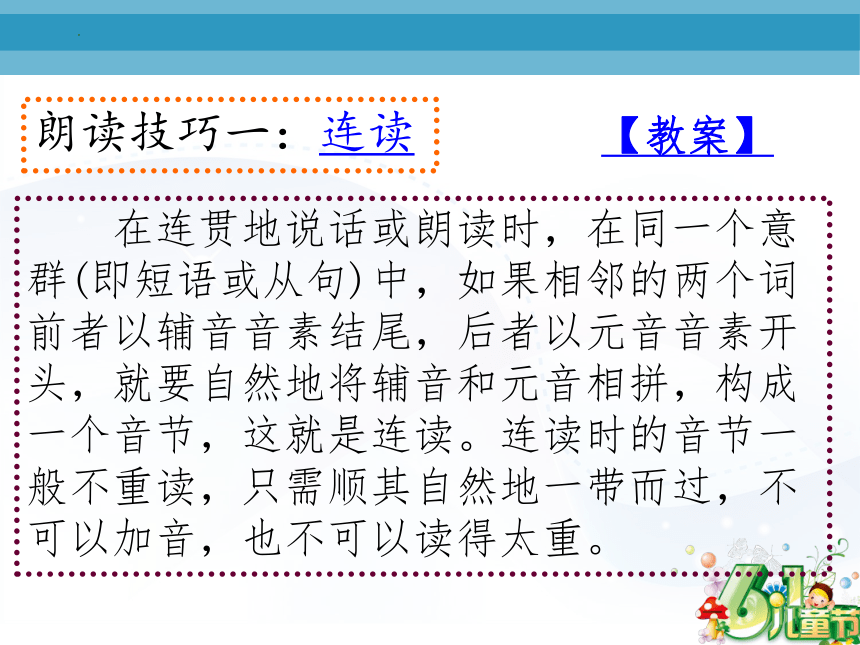2023届广东省高三英语复习听说基本知识及语法常识课件(100张PPT)
文档属性
| 名称 | 2023届广东省高三英语复习听说基本知识及语法常识课件(100张PPT) |  | |
| 格式 | pptx | ||
| 文件大小 | 7.6MB | ||
| 资源类型 | 教案 | ||
| 版本资源 | 通用版 | ||
| 科目 | 英语 | ||
| 更新时间 | 2022-11-04 11:18:30 | ||
图片预览












文档简介
(共100张PPT)
小课程——
【模仿朗读】
原创者:Sandie老师
修改者、讲解者:Ken/Stephen学生
朗读技巧
朗读技巧一:连读
在连贯地说话或朗读时,在同一个意群(即短语或从句)中,如果相邻的两个词前者以辅音音素结尾,后者以元音音素开头,就要自然地将辅音和元音相拼,构成一个音节,这就是连读。连读时的音节一般不重读,只需顺其自然地一带而过,不可以加音,也不可以读得太重。
【教案】
连读
以下几种情况常要连读:
1.(词末)辅音+(词首)元音
【教案】
以下几种情况常要连读:
2.(词末)r/re+(词首)元音
【教案】
以下几种情况常要连读:
3.(词末)辅音+(词首)半元音
【教案】
英语语音中的/j/和/w/是半元音,如果前一个词是以辅音结尾,后一个词是以半元音(特别是/j/)开头,此时也要连读。
【教案】
非~/重读
朗读技巧二:重读与非重读
一般规则:实词重读,虚词不重读。
【教案】
(1)名词、动词、数词、形容词、副词是实词,一般要重读。
(2)冠词、介词、连词、助动词是虚词,一般不重读。
(3)大多数代词不重读,但指示代词和疑问代词要重读。
例如:Janet has gone to school.
【教案】
He is a tall young man with blue eyes.
Who came to see me this evening
注意:在某些情况下,不重读的虚词也可以重读。
【教案】
(1)要特别强调的虚词;
(2)助动词及be动词置句首、否定式以及在作简略回答时;
(3)介词(to除外)在句尾
Would you like a glass of beer
【教案】
What is he waiting for
Who is coming — I am.
朗读技巧四:语调
基本语调
基本语调:
升调(↗)
【教案】
降调(↘)
升降调(∧)
降升调(∨)
平调(→)
语调用法
语调的用法:
1.升调
【教案】
主要用于一般疑问句,带有疑问语气;也可用于祈使句,表示委婉、客气;或用于陈述句,表示疑问,不肯定或不耐烦等。
【教案】
语调的用法:
2.降调
【教案】
只要用于陈述句、特殊疑问句、祈使句(表命令)、感叹句。
【教案】
语调的用法:
3.前升后降调
【教案】
(1)选择疑问句。
【教案】
(2)以状语或状语从句开头的句子。
(3)计数或列举。
【教案】
以 and 相连的几个并列的词或短语,and 前面的都读升调,其后的读降调。
语调的用法:
4.前降后升
【教案】
只要用于带有疑问语气的反意问句。
语调的用法:
4.前降后升
【教案】
如果反意疑问句中,疑问的成分很少,则用降降调。
模仿朗读
【教案】
模仿朗读
(1)You speak English,↘ don’t you ↗
(2)She’s got a stomachache, ↗a sore throat,↗ and a temperature.↘
3)Do you prefer to take a walk↗ or stay at home ↘
【教案】
模仿朗读
(4)When they were twenty three,↗ they both got married ↗and a year later↗ both had sons.↘
意群停顿
朗读技巧五:意群停顿
在朗读长句子的时候,要使朗读流畅、自然,常常需要停顿。但停顿不是随意的,只能在意群之间进行。句子可以按照它的意思和语法结构分成小段,这样的小段就叫意群。意群可以是一个词,一个短语,也可以是并列句中的一个分句或复合句中的一个主、从句等。
【教案】
【教案】
如下面的句子可以这样划分意群:
(1)Tonny only walks a few steps/from his office/to the place/where his wife works.
【教案】
如下面的句子可以这样划分意群:
(2)When I leave Beijing ∕ I will leave∕ with very fond memories ∕ of the city and its people ∕ and with an increased knowledge of China.
Practice makes perfect!
【熟能生巧!】
原创者:Sandie老师
修改者、讲解者:Ken/Stephen学生
小课程——
【模仿朗读】
原创者:Magrock老师
修改者、讲解者:Ken/Stephen学生
轻松一刻
比较:
What ’s Up (→)
What ’s Up (↗)
What ’s Up (↘)
=What’s the matter (with you)
=What’s wrong (with you)
你怎么啦?
附录
学案
简单句
简单句的五种基本句型
(1)主语+不及物动词(S+V)
Everybody smiled.
(2)主语+及物动词+宾语(S+V+O)
He knows everything.
(3)主语+系动词+表语(S+V+P)
附录
学案
(4)主语+及物动词+双宾语(S+V+O+O)
I showed him my passport.
(5)主语+及物动词+宾语+宾补(S+V+O+C)
You made me angry.
The boy looks healthy.
附录
学案
小课程——
【模仿朗读】
原创者:Penny老师
修改者、讲解者:Ken/Stephen学生
扩展
扩展
冠词
1、定冠词的基本用法:
① 表示上文提到过的人或事物。
如:I have bought a book. The book is very useful.
② 用于说话人与听话人心中都有数的人或事物。
如:Close the window, please.
1、定冠词的基本用法:
③ 用于表示世界上独一无二的事物前。
如:the sun, the moon, the earth, the world等。
④ 用于表示方位的名词之前。
如:the east, the right.
1、定冠词的基本用法:
⑤ 用于序数词或形容词的最高级之前。
如:the first, the tallest.
⑥ 用于形容词之前,使其名词化。
如:the sick, the wounded.
1、定冠词的基本用法:
⑦ 用于由普通名词构成的专有名词之前。
如:the United States, the United Nation.
⑧ 用于江河、海洋、海峡、山脉、群岛、建筑物等的名词之前。
如:the Changjiang River, the East Lake.
1、定冠词的基本用法:
⑨ 用于复数姓氏之前,表示“夫妇”或“全家”。
如:The Smiths
⑩ 用于乐器的名词前。
如:play the piano; play the violin.
1、定冠词的基本用法:
⑾ 年代名词前。
如:He lived in the countryside in the 1970s.
⑿ 固定词组中。
如:in the morning (afternoon, evening), on the other hand , at the same time
2、不定冠词的基本用法:
① 泛指一个。
如:There is a book on the table.
② 指人或事物的某一种类。
如:His father is a driver.
如:Longjing is a wonderful tea.
2、不定冠词的基本用法:
③ 指某一个人或事物,但不具体说明。
如:My sister was saved by a PLA man in the fire.
④ 用于某一些表示重量、长度、时间等单位前,表示“每一”。
如:We have meals three times a day.(我们一天吃三餐。)
2、不定冠词的基本用法:
⑤ 表示同样的。
如:They are of an age.(他们是同岁。)
⑥ 表数量,相当于one,但语意较弱。
如:There is a pen and two books on the desk.
2、不定冠词的基本用法:
⑦ 使抽象名词具体化。
如:The little girl is a hand to her mother. (a hand译“帮手”)
⑧ 固定搭配。
如:as a matter of fact , in a hurry, in a word
3、不用冠词的情况:
① 表示总称的复数名词之前。
如:Children love cartoons.(儿童喜欢卡通影片。)
② 不含普通名词的专有名词前。
如:We are studying English.
3、不用冠词的情况:
③ 名词前有指示代词、物主代词、不定代词或名词所有格修饰时。
如:I like this picture; I do not have any money.
如:As time went on, Einstein’s theory proved to be correct.
3、不用冠词的情况:
④ 季节、月份、星期等名词前,一般不用冠词。
如:She likes spring most.
⑤三餐饭前不用冠词。
如:What did you have for lunch
3、不用冠词的情况:
⑥节假日前不用冠词。
如:People give gifts to each other on Christmas Day.
⑦球类和棋类运动的名称前不用冠词。
如: She is fond of playing basketball.
3、不用冠词的情况:
⑧在一些成对出现的短语中不用冠词。
如:arm in arm(手挽手); hand in hand(手牵手); side by side(肩对肩); day and day(日日夜夜); young and old(老老少少); from door to door(挨门挨户); from beginning to end(从头到尾); from morning till night(从早到晚)等。
3、不用冠词的情况:
⑥节假日前不用冠词。
如:People give gifts to each other on Christmas Day.
⑦球类和棋类运动的名称前不用冠词。
如: She is fond of playing basketball.
代词
1.人称代词(主格/宾格)
2.物主代词(形容词性/名词性物主代词)
3.指示代词(such,this,those)
4.相互代词(each other,one another)
5.反身代词
6.不定代词(either, each, other, none, anything)
7.it的用法
1.指代时间、距离、自然现象等
2.指代前面所提到过的事物、想法、性别被认为不重要的人或动物,也可指代未指明但谈话双方都明白的事情或情况等
3.It 可以作形式主语或形式宾语,而把真正的主语或宾语放在后面,真正的主语或宾语由不定式、动名词、从句等充当。
7.it的用法
如:It is kind of you to do me a favor.
如:I think it necessary that we have the meeting.
4.有关it的固定结构
如:It was here that I first met him.
如:I would appreciate it if you could help me.
连词
1.并列连词
常用的并列连词有:
and,as well as,both … and,not only … but also,not … but(不是…而是),neither … nor,either … or,or,but ,yet,for,so,while,when等。
2.从属连词
引导时间状语从句的: after, before, when, as, while, since, until, till, as soon as
引导原因状语从句的: because, since, as
引导让步状语从句的: although, though, no matter(无论), even if (though)
引导条件状语从句的: if, unless, once, so (as) long as
2.从属连词
引导结果状语从句的: so … that …, such … that …
引导目的状语从句的:so that …, in order that …
引导比较状语从句的:as … as …, not so (as) … as …, … than …
引导方式状语从句的:as if …
2.从属连词
引导 主语,宾语或表语从句 的连词主要有:that, whether, if三个。其中that和whether间或还可以引起同位从句和状语从句。
主谓一致
1.语法一致原则
2.逻辑意义一致原则
3.就近一致原则
主谓一致
1.语法一致原则
语法上一致就是谓语动词和主语在单、复数形式上保持一致。
1、以单数名词或代词、动词不定式短语、动名词短语或从句作主语时,谓语动词一般用单数形式;主语为复数时,谓语动词用复数形式。
如:To study English well is not easy.
如: What he said is very important for us all.
1.语法一致原则
由what引导的主语从句,后面的谓语动词多数情况用 单数形式,但若表语是复数或what从句是一个带有复数意义的并列结构时,主句的谓语动词用复数形式。
如:What I bought were three English books.
如: What I say and do is (are) helpful to you.
1.语法一致原则
2、由连接词and或both … and连接起来的合成主语后面,要用复数形式的谓语动词。
如:The writer and artist has come.
① 若and所连接的两个词是指同一个人或物时,它后面的谓语动词就应用单数形式。
1.语法一致原则
如:Every student and every teacher was in the room.
② 由and连接的并列单数主语前如果分别有no, each, every more than a (an) , many a (an)修饰时,其谓语动词要用单数形式。
如: No boy and no girl likes it.
1.语法一致原则
3、主语为单数名词或代词,尽管后面跟有with, together with, except, but, like, as well as, rather than, more than, no less than, besides, including等引起的短语,谓语动词仍用单数形式;若主语为复数,谓语用复数形式。
如:Mr Green, together with his wife and children, has come to China.
1.语法一致原则
如:Nobody but Jim and Mike was on the playground.
如:She, like you and Tom, is very tall.
1.语法一致原则
4、either, neither, each, every 或no +单数名词和由some, any, no, every构成的复合不定代词,都作单数看待。
如:Each of us has a new book.
如:Everything around us is matter.
1.语法一致原则
5、在定语从句时,关系代词that, who, which等作主语时,其谓语动词的数应与句中先行词的数一致。
如:He is one of my friends who are working hard.
如:He is the only one of my friends who is working hard.
1.语法一致原则
6、如果集体名词指的是整个集体,它的谓语动词用单数;如果它指集体的成员,其谓语动词就用复数形式。
这些词有family, class, crowd, committee, population, audience等。
如:Class Four is on the third floor.
如:Class Four are unable to agree upon a monitor.
1.语法一致原则
people, police, cattle等名词一般都用作复数。
如:The police are looking for the lost child.
7、由“a lot of, lots of, plenty of, the rest of, the majority of + 名词”构成的短语以及由“分数或百分数+名词”构成的短语作主语,其谓语动词的数要根据短语中后面名词的数而定。
1.语法一致原则
如:The rest of the lecture is wonderful.
如:50% of the students in our class are girls.
8、在倒装句中,谓语动词的数应与其后的主语一致
如: On the wall are many pictures.
如: Such is the result.
2.逻辑一致原则
逻辑意义一致就是谓语动词的数必须和主语的意义一致(因有时主语形式为单数,但意义为复数;有时形式为复数,但意义为单数)。
如:Which is your bag
1、what, who, which, any, more, all等代词可以是单数,也可是复数,主要靠意思来决定。
2.逻辑一致原则
如:Which are your bags
2、表示“时间、重量、长度、价值”等的名词的复数作主语时,谓语动词通常用单数形式, 这是由于作主语的名词在概念上是一个整体。
如:Thirty minutes is enough for the work.
2.逻辑一致原则
3、若英语是书名、片名、格言、剧名、报名、国名等的复数形式,其谓语动词通常用单数形式。
如:“The Arabian Nights”is an interesting story-book.
4、表数量的短语“one and a half”后接复数名词作主语时,其谓语动词可用单数形式(也可用复数)。
2.逻辑一致原则
如:One and a half apples is (are) left on the table.
5、trousers, glasses, clothes, shoes, 等词作主语时,谓语用复数,但如果这些名词前有a (the) pair of等量词修饰时,谓语动词用单数。
如:My glasses are broken.
如:The pair of shoes under the bed is his.
2.逻辑一致原则
6、“定冠词the + 形容词或分词”,表示某一类人时,动词用复数。
2.就近一致原则
在英语句子中,有时谓语动词的人称和数与最近的主语保持一致。
如:Either the teacher or the students are our friends.
1、当两个主语由either … or, neither … nor, whether … or …, not only … but also连接时,谓语动词和邻近的主语一致。
2.就近一致原则
如:Neither they nor he is wholly right.
如:Is neither he nor they wholly right
2、there be句型be动词单复数取决于其后的主语。如果其后是由and连接的两个主语,则应与靠近的那个主语保持一致。
如:There are two chairs and a desk in the room..
Here引导的句子用法同上。
No pain ,no gain
【一分耕耘,一分收获】
原创者:Penny老师
修改者、讲解者:Ken/Stephen学生
小课程——
【模仿朗读】
原创者:Sandie老师
修改者、讲解者:Ken/Stephen学生
朗读技巧
朗读技巧一:连读
在连贯地说话或朗读时,在同一个意群(即短语或从句)中,如果相邻的两个词前者以辅音音素结尾,后者以元音音素开头,就要自然地将辅音和元音相拼,构成一个音节,这就是连读。连读时的音节一般不重读,只需顺其自然地一带而过,不可以加音,也不可以读得太重。
【教案】
连读
以下几种情况常要连读:
1.(词末)辅音+(词首)元音
【教案】
以下几种情况常要连读:
2.(词末)r/re+(词首)元音
【教案】
以下几种情况常要连读:
3.(词末)辅音+(词首)半元音
【教案】
英语语音中的/j/和/w/是半元音,如果前一个词是以辅音结尾,后一个词是以半元音(特别是/j/)开头,此时也要连读。
【教案】
非~/重读
朗读技巧二:重读与非重读
一般规则:实词重读,虚词不重读。
【教案】
(1)名词、动词、数词、形容词、副词是实词,一般要重读。
(2)冠词、介词、连词、助动词是虚词,一般不重读。
(3)大多数代词不重读,但指示代词和疑问代词要重读。
例如:Janet has gone to school.
【教案】
He is a tall young man with blue eyes.
Who came to see me this evening
注意:在某些情况下,不重读的虚词也可以重读。
【教案】
(1)要特别强调的虚词;
(2)助动词及be动词置句首、否定式以及在作简略回答时;
(3)介词(to除外)在句尾
Would you like a glass of beer
【教案】
What is he waiting for
Who is coming — I am.
朗读技巧四:语调
基本语调
基本语调:
升调(↗)
【教案】
降调(↘)
升降调(∧)
降升调(∨)
平调(→)
语调用法
语调的用法:
1.升调
【教案】
主要用于一般疑问句,带有疑问语气;也可用于祈使句,表示委婉、客气;或用于陈述句,表示疑问,不肯定或不耐烦等。
【教案】
语调的用法:
2.降调
【教案】
只要用于陈述句、特殊疑问句、祈使句(表命令)、感叹句。
【教案】
语调的用法:
3.前升后降调
【教案】
(1)选择疑问句。
【教案】
(2)以状语或状语从句开头的句子。
(3)计数或列举。
【教案】
以 and 相连的几个并列的词或短语,and 前面的都读升调,其后的读降调。
语调的用法:
4.前降后升
【教案】
只要用于带有疑问语气的反意问句。
语调的用法:
4.前降后升
【教案】
如果反意疑问句中,疑问的成分很少,则用降降调。
模仿朗读
【教案】
模仿朗读
(1)You speak English,↘ don’t you ↗
(2)She’s got a stomachache, ↗a sore throat,↗ and a temperature.↘
3)Do you prefer to take a walk↗ or stay at home ↘
【教案】
模仿朗读
(4)When they were twenty three,↗ they both got married ↗and a year later↗ both had sons.↘
意群停顿
朗读技巧五:意群停顿
在朗读长句子的时候,要使朗读流畅、自然,常常需要停顿。但停顿不是随意的,只能在意群之间进行。句子可以按照它的意思和语法结构分成小段,这样的小段就叫意群。意群可以是一个词,一个短语,也可以是并列句中的一个分句或复合句中的一个主、从句等。
【教案】
【教案】
如下面的句子可以这样划分意群:
(1)Tonny only walks a few steps/from his office/to the place/where his wife works.
【教案】
如下面的句子可以这样划分意群:
(2)When I leave Beijing ∕ I will leave∕ with very fond memories ∕ of the city and its people ∕ and with an increased knowledge of China.
Practice makes perfect!
【熟能生巧!】
原创者:Sandie老师
修改者、讲解者:Ken/Stephen学生
小课程——
【模仿朗读】
原创者:Magrock老师
修改者、讲解者:Ken/Stephen学生
轻松一刻
比较:
What ’s Up (→)
What ’s Up (↗)
What ’s Up (↘)
=What’s the matter (with you)
=What’s wrong (with you)
你怎么啦?
附录
学案
简单句
简单句的五种基本句型
(1)主语+不及物动词(S+V)
Everybody smiled.
(2)主语+及物动词+宾语(S+V+O)
He knows everything.
(3)主语+系动词+表语(S+V+P)
附录
学案
(4)主语+及物动词+双宾语(S+V+O+O)
I showed him my passport.
(5)主语+及物动词+宾语+宾补(S+V+O+C)
You made me angry.
The boy looks healthy.
附录
学案
小课程——
【模仿朗读】
原创者:Penny老师
修改者、讲解者:Ken/Stephen学生
扩展
扩展
冠词
1、定冠词的基本用法:
① 表示上文提到过的人或事物。
如:I have bought a book. The book is very useful.
② 用于说话人与听话人心中都有数的人或事物。
如:Close the window, please.
1、定冠词的基本用法:
③ 用于表示世界上独一无二的事物前。
如:the sun, the moon, the earth, the world等。
④ 用于表示方位的名词之前。
如:the east, the right.
1、定冠词的基本用法:
⑤ 用于序数词或形容词的最高级之前。
如:the first, the tallest.
⑥ 用于形容词之前,使其名词化。
如:the sick, the wounded.
1、定冠词的基本用法:
⑦ 用于由普通名词构成的专有名词之前。
如:the United States, the United Nation.
⑧ 用于江河、海洋、海峡、山脉、群岛、建筑物等的名词之前。
如:the Changjiang River, the East Lake.
1、定冠词的基本用法:
⑨ 用于复数姓氏之前,表示“夫妇”或“全家”。
如:The Smiths
⑩ 用于乐器的名词前。
如:play the piano; play the violin.
1、定冠词的基本用法:
⑾ 年代名词前。
如:He lived in the countryside in the 1970s.
⑿ 固定词组中。
如:in the morning (afternoon, evening), on the other hand , at the same time
2、不定冠词的基本用法:
① 泛指一个。
如:There is a book on the table.
② 指人或事物的某一种类。
如:His father is a driver.
如:Longjing is a wonderful tea.
2、不定冠词的基本用法:
③ 指某一个人或事物,但不具体说明。
如:My sister was saved by a PLA man in the fire.
④ 用于某一些表示重量、长度、时间等单位前,表示“每一”。
如:We have meals three times a day.(我们一天吃三餐。)
2、不定冠词的基本用法:
⑤ 表示同样的。
如:They are of an age.(他们是同岁。)
⑥ 表数量,相当于one,但语意较弱。
如:There is a pen and two books on the desk.
2、不定冠词的基本用法:
⑦ 使抽象名词具体化。
如:The little girl is a hand to her mother. (a hand译“帮手”)
⑧ 固定搭配。
如:as a matter of fact , in a hurry, in a word
3、不用冠词的情况:
① 表示总称的复数名词之前。
如:Children love cartoons.(儿童喜欢卡通影片。)
② 不含普通名词的专有名词前。
如:We are studying English.
3、不用冠词的情况:
③ 名词前有指示代词、物主代词、不定代词或名词所有格修饰时。
如:I like this picture; I do not have any money.
如:As time went on, Einstein’s theory proved to be correct.
3、不用冠词的情况:
④ 季节、月份、星期等名词前,一般不用冠词。
如:She likes spring most.
⑤三餐饭前不用冠词。
如:What did you have for lunch
3、不用冠词的情况:
⑥节假日前不用冠词。
如:People give gifts to each other on Christmas Day.
⑦球类和棋类运动的名称前不用冠词。
如: She is fond of playing basketball.
3、不用冠词的情况:
⑧在一些成对出现的短语中不用冠词。
如:arm in arm(手挽手); hand in hand(手牵手); side by side(肩对肩); day and day(日日夜夜); young and old(老老少少); from door to door(挨门挨户); from beginning to end(从头到尾); from morning till night(从早到晚)等。
3、不用冠词的情况:
⑥节假日前不用冠词。
如:People give gifts to each other on Christmas Day.
⑦球类和棋类运动的名称前不用冠词。
如: She is fond of playing basketball.
代词
1.人称代词(主格/宾格)
2.物主代词(形容词性/名词性物主代词)
3.指示代词(such,this,those)
4.相互代词(each other,one another)
5.反身代词
6.不定代词(either, each, other, none, anything)
7.it的用法
1.指代时间、距离、自然现象等
2.指代前面所提到过的事物、想法、性别被认为不重要的人或动物,也可指代未指明但谈话双方都明白的事情或情况等
3.It 可以作形式主语或形式宾语,而把真正的主语或宾语放在后面,真正的主语或宾语由不定式、动名词、从句等充当。
7.it的用法
如:It is kind of you to do me a favor.
如:I think it necessary that we have the meeting.
4.有关it的固定结构
如:It was here that I first met him.
如:I would appreciate it if you could help me.
连词
1.并列连词
常用的并列连词有:
and,as well as,both … and,not only … but also,not … but(不是…而是),neither … nor,either … or,or,but ,yet,for,so,while,when等。
2.从属连词
引导时间状语从句的: after, before, when, as, while, since, until, till, as soon as
引导原因状语从句的: because, since, as
引导让步状语从句的: although, though, no matter(无论), even if (though)
引导条件状语从句的: if, unless, once, so (as) long as
2.从属连词
引导结果状语从句的: so … that …, such … that …
引导目的状语从句的:so that …, in order that …
引导比较状语从句的:as … as …, not so (as) … as …, … than …
引导方式状语从句的:as if …
2.从属连词
引导 主语,宾语或表语从句 的连词主要有:that, whether, if三个。其中that和whether间或还可以引起同位从句和状语从句。
主谓一致
1.语法一致原则
2.逻辑意义一致原则
3.就近一致原则
主谓一致
1.语法一致原则
语法上一致就是谓语动词和主语在单、复数形式上保持一致。
1、以单数名词或代词、动词不定式短语、动名词短语或从句作主语时,谓语动词一般用单数形式;主语为复数时,谓语动词用复数形式。
如:To study English well is not easy.
如: What he said is very important for us all.
1.语法一致原则
由what引导的主语从句,后面的谓语动词多数情况用 单数形式,但若表语是复数或what从句是一个带有复数意义的并列结构时,主句的谓语动词用复数形式。
如:What I bought were three English books.
如: What I say and do is (are) helpful to you.
1.语法一致原则
2、由连接词and或both … and连接起来的合成主语后面,要用复数形式的谓语动词。
如:The writer and artist has come.
① 若and所连接的两个词是指同一个人或物时,它后面的谓语动词就应用单数形式。
1.语法一致原则
如:Every student and every teacher was in the room.
② 由and连接的并列单数主语前如果分别有no, each, every more than a (an) , many a (an)修饰时,其谓语动词要用单数形式。
如: No boy and no girl likes it.
1.语法一致原则
3、主语为单数名词或代词,尽管后面跟有with, together with, except, but, like, as well as, rather than, more than, no less than, besides, including等引起的短语,谓语动词仍用单数形式;若主语为复数,谓语用复数形式。
如:Mr Green, together with his wife and children, has come to China.
1.语法一致原则
如:Nobody but Jim and Mike was on the playground.
如:She, like you and Tom, is very tall.
1.语法一致原则
4、either, neither, each, every 或no +单数名词和由some, any, no, every构成的复合不定代词,都作单数看待。
如:Each of us has a new book.
如:Everything around us is matter.
1.语法一致原则
5、在定语从句时,关系代词that, who, which等作主语时,其谓语动词的数应与句中先行词的数一致。
如:He is one of my friends who are working hard.
如:He is the only one of my friends who is working hard.
1.语法一致原则
6、如果集体名词指的是整个集体,它的谓语动词用单数;如果它指集体的成员,其谓语动词就用复数形式。
这些词有family, class, crowd, committee, population, audience等。
如:Class Four is on the third floor.
如:Class Four are unable to agree upon a monitor.
1.语法一致原则
people, police, cattle等名词一般都用作复数。
如:The police are looking for the lost child.
7、由“a lot of, lots of, plenty of, the rest of, the majority of + 名词”构成的短语以及由“分数或百分数+名词”构成的短语作主语,其谓语动词的数要根据短语中后面名词的数而定。
1.语法一致原则
如:The rest of the lecture is wonderful.
如:50% of the students in our class are girls.
8、在倒装句中,谓语动词的数应与其后的主语一致
如: On the wall are many pictures.
如: Such is the result.
2.逻辑一致原则
逻辑意义一致就是谓语动词的数必须和主语的意义一致(因有时主语形式为单数,但意义为复数;有时形式为复数,但意义为单数)。
如:Which is your bag
1、what, who, which, any, more, all等代词可以是单数,也可是复数,主要靠意思来决定。
2.逻辑一致原则
如:Which are your bags
2、表示“时间、重量、长度、价值”等的名词的复数作主语时,谓语动词通常用单数形式, 这是由于作主语的名词在概念上是一个整体。
如:Thirty minutes is enough for the work.
2.逻辑一致原则
3、若英语是书名、片名、格言、剧名、报名、国名等的复数形式,其谓语动词通常用单数形式。
如:“The Arabian Nights”is an interesting story-book.
4、表数量的短语“one and a half”后接复数名词作主语时,其谓语动词可用单数形式(也可用复数)。
2.逻辑一致原则
如:One and a half apples is (are) left on the table.
5、trousers, glasses, clothes, shoes, 等词作主语时,谓语用复数,但如果这些名词前有a (the) pair of等量词修饰时,谓语动词用单数。
如:My glasses are broken.
如:The pair of shoes under the bed is his.
2.逻辑一致原则
6、“定冠词the + 形容词或分词”,表示某一类人时,动词用复数。
2.就近一致原则
在英语句子中,有时谓语动词的人称和数与最近的主语保持一致。
如:Either the teacher or the students are our friends.
1、当两个主语由either … or, neither … nor, whether … or …, not only … but also连接时,谓语动词和邻近的主语一致。
2.就近一致原则
如:Neither they nor he is wholly right.
如:Is neither he nor they wholly right
2、there be句型be动词单复数取决于其后的主语。如果其后是由and连接的两个主语,则应与靠近的那个主语保持一致。
如:There are two chairs and a desk in the room..
Here引导的句子用法同上。
No pain ,no gain
【一分耕耘,一分收获】
原创者:Penny老师
修改者、讲解者:Ken/Stephen学生
